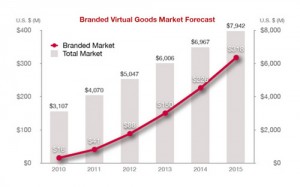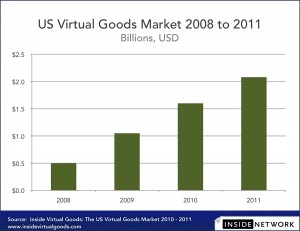Virtual Entrepreneurship — Could Home Support It?
How much will you pay for this polygon?
Ever thought to yourself that it’d be incredibly cool, since you spend so much time on Home, to figure out a way to make a few bucks from it?
You’re not alone.
The U.S. virtual goods market is staggeringly large. In 2010, social games accounted for $835 million of a $1.6 billion industry – which, in 2011, is projected to top $2.1B.
For console manufacturers, who typically sell their hardware at a loss, social gaming like PlayStation Home potentially represents a high-margin revenue stream. While Sony has been very tight-lipped about PSN’s (and Home’s) profitability, Microsoft’s Xbox Live generates in excess of $1 billion annually. Hence why Sony recently introduced the subscription-based PlayStation Plus. You didn’t think that was a coincidence, did you?
It should also come as no surprise that, given these staggering figures, virtual entrepreneurs would look for opportunity when it presents itself.
Let’s take Entropia Universe as an example. For those who aren’t familiar with it, it’s one of the biggest PC MMO titles in the world. Real money can be converted into in-game money known as PEDs (Project Entropia Dollars), which can be converted back into actual currency at a fixed exchange rate (with a transaction fee, of course).
 In 2005, a gentleman named Jon Jacobs bought an in-game asteroid for $100,000. Last month, after spending years building it into an Entropia hotspot known as Club NEVERDIE, he sold off his in-world assets and walked away with $635,000. Oh, and he made his initial investment back in only eight months.
In 2005, a gentleman named Jon Jacobs bought an in-game asteroid for $100,000. Last month, after spending years building it into an Entropia hotspot known as Club NEVERDIE, he sold off his in-world assets and walked away with $635,000. Oh, and he made his initial investment back in only eight months.
Great googly-moogly.
Now let’s take a look at Second Life. In many ways, it’s the antithesis of Home: users create the bulk of the in-world content. More than 250,000 virtual items are created every day in Second Life, and while only the parent developer is the source of virtual real estate (similar to Home’s personal spaces), there are very few limits as to what can be created with the purchased “land” that you acquire.
Granted, Second Life is also 18-and-up exclusively, and has none of the nanny-state restrictions Sony places on Home. Savvy (and lucky) landlord entrepreneurs there, just as in Entropia, can actually generate sufficient income to meet their needs in real life.
Is Sony missing out on something here?
It’s worth noting that Home’s primary purpose for existence is different than either of the two other virtual realities I’ve cited; Home is (at present) first and foremost a platform to promote video game and console peripheral sales. It seems to be viewed by Sony more as a means to an end than a business entity unto itself.
Further, it can be surmised that the bulk of Home’s population, being console gamers, are likely teenagers (many of whom are underaged), with little disposable income of their own. Hence why Home is free to use.
So here’s a question: is that really the best market strategy for Home? 
Presently, Home’s infrastructure doesn’t really lend itself to featuring true user-generated content, beyond the non-ecommerce bits of entertainment playing in the Community Theater. In order to generate content for Home, you have to be a licensed Home Developer (check out more info at http://home.scedev.net if you want), and the content has to meet Sony’s legal and quality-assurance requirements.
Sony has tremendous control over what appears in Home and what doesn’t. The major advantage of this is the homogeneity of the product: the level of quality and the nature of the content in each new public and private space is guaranteed to be at a certain level. Considering the rather juvenile conversations I see taking place in Home every day, this isn’t a bad thing.
The disadvantage of Home’s current format is that frankly, for older users who want to be a bit more creative with the platform than coming up with increasingly funky ways to dress-up a clubhouse with fifty items or less – older users who have disposable income, and perhaps are looking to mix a bit of e-commerce with their gaming – there really isn’t anything in Home to satisfy that. There’s really no way for a user to produce his own public or private space (or virtual items), make them available on the Home navigator, and be a virtual landlord and entrepreneur.
It’s worth noting, however, from Sony’s own official Q&A, under “Commerce & Partnerships”:
Q: Is Home a commercial environment?
A: Home is primarily a platform for social interaction and the intention is not to create a space for purely conducting ecommerce. Home prioritises community and entertainment over ecommerce. That said, we believe that there will be ample opportunities for businesses and individuals alike to generate significant revenues from the Home platform.
Q: Will we be able to sell products (other than Home assets) online?
A: Eventually Home will not only support the merchandising of virtual assets, but also will provide cross-promotional opportunities for selling physical goods online.
And, further, under “Policy” in the Q&A:
Q: Will users be able to sell things to each other?
A: Ultimately, an auction service will be implemented that will allow users to sell their Home assets and user-created content to other users.
Q: Can I earn money in Home?
A: As noted above, there will be eventually opportunities for user-to-user auctions.
The big question is whether or not this can actually happen with Home. Given the legal hurdles and e-commerce security issues that would arise with these features, Sony may decide that Home’s profit margins are just fine without the incurred cost and risks.
Imagine, however, a Home in which you could generate your own content. Your own virtual items. Your own public space. And imagine putting those creations to the test. Think your public space is worth the price of admission? Imagine being able to find out.
It would make Home an extremely interesting place to me. I wonder if, one day, someone will turn into the first Jon Jacobs of Home. Virtual goods are big business, and it may be worth it to Sony to examine the possibilities of giving users the tools necessary to become virtual entrepreneurs within Home – and collecting healthy transaction fees in the process.
I, for one, would love to see it happen.



 LinkedIn
LinkedIn Twitter
Twitter
A very interesting topic. As a former digital artist, there’s definitely a market for this type of stuff.
Hobbyists and professionals both give freebies and sell their work in various forums across the internet. This would be a fantastic way for these otherwise static objects to become useful far beyond looking pretty in a poster print or minute long test animation.
Digging deeper into the legal ramifications of the piece though — There’s a ton of infringement among meshes and textures too -- a black market sort of emerged once higher priced digital models came out. This would carry over into Home no doubt, making Sony’s approval process that much more difficult.
Take something like Modnation Racers. There are unlicensed creations all over the place, which I’m really sort of surprised at. Yeah, it’s cool but it isn’t really the players original creation.
I like the idea of virtual goods. I’m not sure how Second Life or Entropia handle such problems, either.
I’m just not sure if it’s practical without some major policing — even then, something’s bound to slip though. I wonder then, if it’s even worth the risk to the platform.
Excellent points; Sony may likely decide that the legal ramifications of such creative freedom are simply too monstrous to allow. Hence why they only allow licensed third-party developers with original intellectual properties.
It’s highly likely that Sony will continue to be very restrictive when it comes to user-generated content, and probably never allow any such e-commerce to take place. After all, Sony doesn’t need it to survive, compared to other MMO programs out there.
I will admit, though, on a personal front…the freedom and entrepreneurial potential of something like Second Life is highly appealing. Home, I think, tends to target a younger demographic overall.
As an aside: you mentioned you’re a former digital artist, and HSM’s art department *is* looking for layout artists right now…
I am looking forward to auctioning off Villain’s Lair if the auction feature becomes reality which would be strange to have it become reality in a virtual world.
This whole thing of buying virtual items with real money is sometimes mind boggling. At least the stuff lasts longer than food.
Buying virtual items with real money is, at face value, a bizarre value proposition. I liken it to purchasing an IMAX movie ticket. What am I really buying? A slip of paper, or an emotional experience? That’s my own personal justification for the (not insubstantial) amount of money I’ve invested into Home.
I really would like to see a “discard” feature for personal spaces and items. If Home never supports user-generated e-commerce, at least allow me to simply dump a commodity I’ve bought and no longer use.
C’mon guys, people have been making purchases of ‘intangibles’ throughout history. The most compelling emotion-based purchases people make are for experiences. Otherwise, prostitution would not exist. All the customer takes with him are the memories (and maybe a STD). Leisure travel would be a trip to the backyard hammock. No one would have HBO. (I can go on with this list, but I think you got the message).
BTW. I would much rather have an option to give away personal spaces and items to friends rather than just discard.